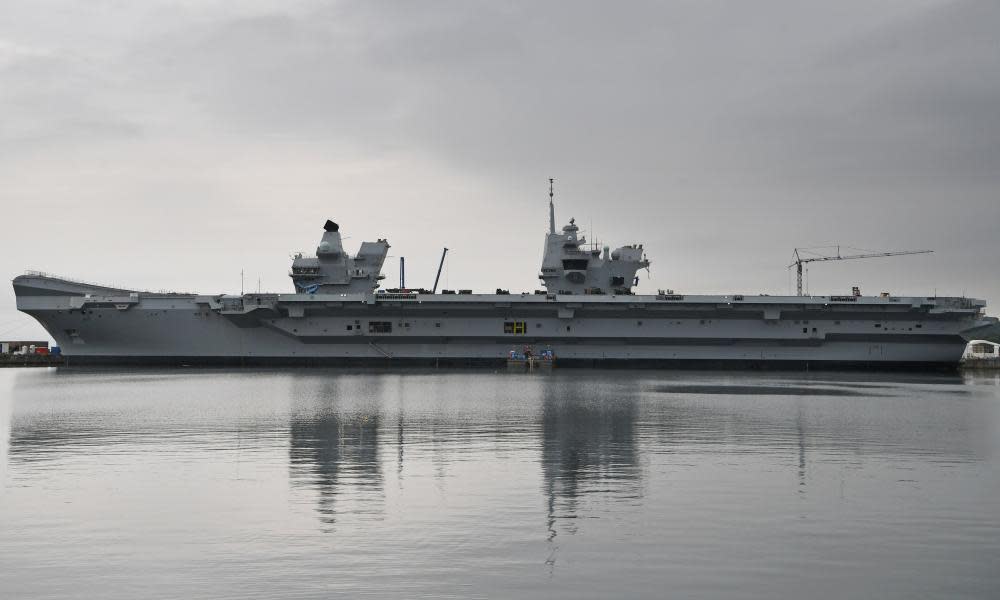South China Sea: UK could send aircraft carrier to back Australian vessels

Australia and the UK are discussing plans for the British aircraft carrier HMS Queen Elizabeth to be sent to the Pacific amid tensions over China’s militarisation in the South China Sea.
The Australian defence minister, Marise Payne, and the foreign minister, Julie Bishop, have discussed joint naval operations in the Pacific region with the UK defence secretary, Gavin Williamson, during their visit this week.
In an effort to highlight the defence ties, Williamson and Payne visited BAe Systems shipyards on the Clyde in Glasgow to inspect new Type 26 frigates of the kind Australia bought last month in a £20bn ($36bn) deal, and the UK nuclear submarine base at Faslane.
At a joint news conference in Edinburgh on Friday, which included the UK foreign secretary, Jeremy Hunt, Bishop said there had a been a distinct shift in “great power relations” that had fuelled an unprecedented level of global volatility.
No one mentioned China’s appropriation and militarisation of islands claimed by other south-east Asian countries – it has built airbases and installed missile systems close to its neighbours and increased its control of regional sea lanes.
Bishop referred instead to the challenges to international “norms and conventions” in the Pacific region. Payne said there were clear threats to the “rules-based international order”.
The four ministers said these threats justified greater defence and security cooperation between the UK and Australia, supported by an increase in British diplomatic outposts in south-Pacific countries such as Tonga and Vanuatu.
“At such a critical juncture in world affairs, we feel it is vital for like-minded nations to join together to promote peace and stability,” Bishop said. “We couldn’t be more delighted that the UK will be taking an increasing role in the Indo-Pacific.”
Control of the South China Sea is one of the most contentious and explosive diplomatic issues in East Asia. For centuries, various regional powers have laid claim to the sea, which is rich in fisheries and serves as a shipping lane for more than half of the world’s oil tanker traffic.
China maintains fierce territorial disputes with Vietnam, Taiwan, Malaysia, Brunei, and the Philippines over the 3.5m sq km stretch of water that is also believed to have significant oil and gas reserves. At the peak of animosity during the 1970s and 1980s, China and Vietnam used force several times, resulting in dozens of deaths and several sunken ships.
Chinese President Xi Jinping has vowed to “resolutely defend” the region. During the past few years, Beijing has dredged sand on coral reefs to transform them into islands that it uses as military bases, fitted with missile launchers, runways, barracks and radar facilities.
The US has grown increasingly alarmed by the military build up. Washington has become involved in the disputes, backing those that oppsoe China and conducting naval patrols.
In 2016, an international tribunal in The Hague overwhelmingly backed the Philippines in its dispute against Chinese control of atolls near its shores. However, Philippine President Rodrigo Duterte has looked to China as an economic partner and has not pursued the issue.
Citing an increased threat from submarines in the Pacific, operated by unnamed countries, Williamson highlighted Australia’s decision to buy nine Type 26 frigates, which will be built by BAe in Adelaide, and renamed by the Royal Australian Navy as Hunter class vessels.
“We have started to see a step change in our relationship,” he said. “For the first time since 2013, Britain has been deploying ships to the Pacific region. We have three this year, and this isn’t something we want to see as a flash in the pan but actually a commitment to the region that goes forward over the coming years.
“We’re very much hoping and going to work together on deploying HMS Queen Elizabeth to the Pacific and hopefully sailing side by side with Australian vessels.
“And we want to make sure that everyone around the world understands that these two great nations are the greatest of allies.”
Deploying HMS Queen Elizabeth to Australian waters would be a big investment for Britain’s Royal Navy. Once operational in 2020, it would normally travel with a “carrier strike group” involving several frigates for anti-submarine warfare, destroyers for air defence and potentially a hunter killer submarine.
Bishop and Hunt were also asked about Donald Trump’s demands that Western countries double their defence spending, and whether that was achievable. Bishop said Trump had made “a very valid point” about the need for increased defence spending and “burden sharing” among US allies.
Payne said the Australian government was on track to increase defence spending to 2% of GDP before the target date of 2023-24, through a “very solid program” of updating military equipment, including buying US F35 fighters and E18 Growler electronic warfare aircraft, and future submarines.
Hunt, who was appointed foreign secretary after Boris Johnson’s recent resignation in protest at the UK government’s Brexit policy, said he too believed Trump “has a point” about those Nato countries that had not met the alliance’s target of spending 2% of GDP on defence.

 Yahoo News
Yahoo News 
